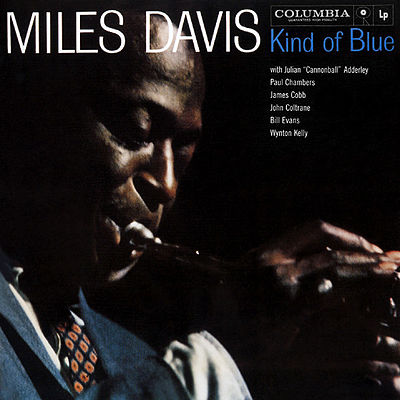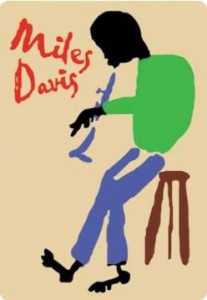 The recording date
The recording date
Fifty years ago this year (2009) trumpeter extraordinaire Miles Davis went into a studio in New York with six of the top jazz musicians of the day and laid down five tracks which have together made up a unique jazz album which is still rated as not only the top selling jazz album of all time, but one of the artistically most influential.
This album, loved by musicians of many different tastes, is Kind of Blue , an artistic text of rare beauty, a soundscape that draws the listener into a space of intense musical collaboration and deep inspiration.
The musicians on the album, which has been re-released many times over the years, were Cannonball Adderley on alto sax, the inimitable John Coltrane on tenor sax, Bill Evans on piano, Paul Chambers on bass, Jimmy Cobb on drums, and, on one track, Wynton Kelly on piano.
The musicians went into the Columbia studio on 2 March 1959 and on that day laid down three numbers: “So What?”, “Freddie Freeloader”, and “Blue in Green”. Kelly played only on “Freddie Freeloader”.
The other tracks, “All Blues” and “Flamenco Sketches” were recorded on 22 April 1959.
The break with bebop
The album marked Miles’s decisive break with bebop, at least in studio recordings. Kind of Blue is a triumph of the modal approach to jazz, and, according to his biographer Ian Carr, “brought to even greater heights the brooding, meditative side of his music which had revealed itself for the first time on (Charlie) Parker’s ‘Now’s the Time’ session in November 1945.”
The album is remarkable for many things and one of the most impressive to the listener is the way the music hangs together and makes for a complete artistic whole rather than just a collection of songs, although each song is also complete in itself.
Key to the whole feel of the album is Evans on piano who brought his own sensibilities to the music and built on the ideas that Miles sketched our for the musicians.
The pieces were not rehearsed beforehand and the musicians had only minimal instructions on how Miles wanted the numbers to sound. Which is why, in the liner notes to the original release, Evans wrote, “you will hear something close to pure spontaneity in these performances.”
Track 1: So What
The opening track, “So What”, sets the mood and tone for the whole album, with an impressionistic introduction from Evans which leads into a riff played by Chambers and is answered by the horns in three-part harmony, in a variation on the call-and-response technique. It is one of the most recognised numbers in all of jazz.
The solos on “So What” are taken by Miles first, followed by Coltrane, Adderley and finally Evans again. Evans’ solo is backed by the horns palying a variation on the response in the first section.
Track 2: Freddie Freeloader
The next track, the only one on which Kelly played, is “Freddie Freeloader” which is a true twelve-bar blues with Kelly taking the first solo, a brilliant bluesy romp, followed by Miles, Coltrane, Adderley and then a short bass solo by Chambers with Kelly doing some brilliant comping behind the bass.
Track 3: Blue in Green
Although all the tracks on Kind of Blue are listed as being composed by Miles, the track “Blue in Green” is somewhat disputed, as Evans later recounted: “One day at Miles’s apartment, he wrote on some manuscript paper the symbols for G minor and A augmented, and he said, ‘What would you do with that?’ I didn’t really know, but I went home and wrote ‘Blue in Green'”.
As Carr wrote in his biography of Miles: “This begs the question of what, precisely, the act of composition in jazz consists.” Carr goes on to say that “In a Zen pupil-and-master sense, by pointing Evans in a particular direction, Miles was certainly ‘composing’ himself.”
Whatever, the number is a beautiful ballad which shows up both Evans’ and Miles’s playing in a kind of lapidary clarity. Miles’s use of the Harmon mute, which was to become something of a trademark with him, is almost painfully poignant, dripping melancholy and wistfulness.
Track 4: All Blues
The track which opened side two of the original vinyl LP release, was “All Blues” which Miles composed originally in 4/4 time, but when they got to the studio, Miles said, “it hit me that it should be in 3/4. I hadn’t thought of it like that before, but it was exactly right.”
This number is built up of layers of sound from the drums playing a steady 3/4 rhythm, and the bass a single note per bar, over which the horns play a repetitive harmonised three-note riff with Miles using his Harmon mute again to make interpolations as he wanted to. He then removes the mute to play the first solo, bringing a whole new texture to the playing of the other musicians.
Track 5: Flamenco Sketches
The final number on the album is”Flamenco Sketches” which is another ballad. Again the question of who composed it comes up, but it is generally accredited to Davis.
The piece opens with some sombre bass notes with Evans playing some quiet chords over the bass before Miles comes in with some beautiful melodic inventions using the Harmon mute again. The bass is particularly beautiful in the opening bars, with an understated gravitas.
Coltrane then gets into the act with an amazingly soulful solo mostly in the lower register of his horn, which makes the contrast with the relative sparsity of higher register notes all the more interesting. Adderley follows with an interesting alto solo that keeps the soulful mood going into the higher end of the scale.
Evans’ solo starts off so minimalistically that its almost not there at all. Just a few quiet and well-chosen notes answering the bass, ending with a few rippling chords before Miles come in again with the plaintive sound of the Harmon mute, with long notes stretching almost, it feels, to infinity, until the number just quietly ends.
Summing up
The album was released by Columbia on 17 August 1959 and has been influential ever since. In an All About Jazz review of the album Philip B. Pape in 1999, he called the album “a defining moment of twentieth century music.”
Richard Cook and Brian Morton, in the 1994 Penguin Guide to Jazz on CD, LP and Cassette, wrote that the “steady mid-tempos and plaintive voicings on ‘So What’ and ‘All Blues’ establish further the weightless, haunting qualities of the music, which no collection, serious or casual, should be without.”
So truly an anniversary to be celebrated, these 50 years of superlative and innovative music which still sounds fresh and, even after all that has happened in music in the intervening years, almost daring in its minimalist, modal approach.
Copyright Notice
The text and all images on this page, unless otherwise indicated, are by Tony McGregor who hereby asserts his copyright on the material. Should you wish to use any of the text or images feel free to do so with proper attribution and, if possible, a link back to this page. Thank you.
© Tony McGregor 2009

